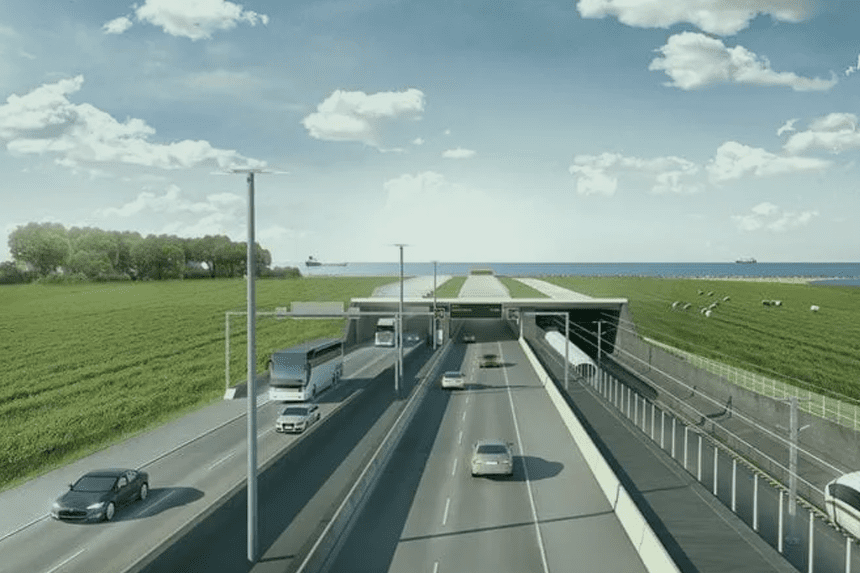The Fehmarnbelt Tunnel Project is reshaping the future of transportation across Northern Europe. Connecting Denmark and Germany beneath the Baltic Sea, this ambitious infrastructure project is set to become the world’s longest immersed road and rail tunnel. Not only will it revolutionize cross-border travel, but it will also foster stronger economic ties, reduce environmental impact, and deliver benefits to local communities on both sides of the border.
Why Was the Fehmarnbelt Tunnel Project Initiated?
For decades, the journey between Denmark and Germany involved a 45-minute ferry crossing from Rødbyhavn to Puttgarten. While efficient for its time, it was not ideal for freight transport, consistent schedules, or environmental impact. Road and rail traffic faced delays, and growing demand for greener, faster connections pushed Europe to look for smarter solutions.
The Fehmarnbelt Tunnel Project was conceived to meet this demand. It represents not just a leap in transport efficiency but a bold commitment to sustainable infrastructure. The idea is simple: build a fixed link between Scandinavia and central Europe to reduce travel time, cut emissions, and enhance regional growth.
What Makes the Tunnel Unique in Design and Construction?arnbelt Tunnel Project Initiated?
Unlike many other tunnels that are bored through rock beneath the seabed, the Fehmarnbelt tunnel is made from prefabricated concrete elements. Each of these giant segments is 217 meters long and weighs over 73,000 tonnes. They are produced at a massive construction site on the Danish island of Lolland and then floated out to sea, to be lowered into a trench dug into the seabed.
Engineers opted for an immersed tunnel due to the Baltic Sea’s soft layers of clay and chalk. Boring through such material would be unstable and expensive. A bridge was considered early in planning, but strong winds and heavy shipping traffic made a submerged option more practical and safe.
By using GPS-guided systems and underwater cameras, these elements are placed with pinpoint accuracy—within 15 millimeters. Once installed, they are connected like Lego bricks to form a continuous tunnel, which will include two rail tubes, two road tubes, and a central service and emergency corridor.
How Will the Tunnel Improve European Transportation?
One of the most significant impacts of the Fehmarnbelt Tunnel Project will be the dramatic reduction in travel time. By replacing the ferry, drivers will make the crossing in just 10 minutes, and high-speed trains will complete the journey in only 7 minutes. As a result, the rail trip from Copenhagen to Hamburg will shrink from five hours to just 2.5.
These time savings don’t just benefit passengers. Freight companies will enjoy faster and more reliable transport, which boosts supply chain efficiency across Europe. As a critical part of the EU’s Trans-European Transport Network (TEN-T), the tunnel is aligned with long-term goals to make rail a preferred mode of travel.
In addition, the route will cut 160 kilometers from current travel distances, meaning lower fuel consumption and a measurable reduction in carbon emissions. This helps meet Europe’s climate targets by making transport both faster and cleaner.
What Are the Economic Benefits of the Fehmarnbelt Tunnel?
Beyond transportation, the Fehmarnbelt Tunnel Project is expected to bring significant economic advantages. Funded mainly by Denmark, with €1.3 billion from the European Commission, the tunnel’s total budget is around €7.4 billion. Though this is a large investment, toll revenues will eventually repay the cost over approximately 40 years.
More importantly, the tunnel is expected to be a game changer for the Danish region of Lolland, one of the country’s most economically challenged areas. New jobs, increased tourism, better access to markets, and improved logistics will stimulate growth across multiple sectors.
Residents are already seeing change. Businesses are planning to invest in the region, and younger generations are looking forward to more opportunities without having to move away from home. Read another article on why are mortgage offers being withdrawn by lenders?“
How Does the Tunnel Address Environmental Concerns?
Major infrastructure projects often face environmental scrutiny, and the Fehmarnbelt Tunnel Project is no exception. Several conservation groups, particularly in Germany, raised concerns about potential harm to marine ecosystems. Harbor porpoises, a protected species in the Baltic Sea, are especially sensitive to underwater noise and construction activity.
To address this, the project includes extensive environmental monitoring and mitigation strategies. A 300-hectare wetland area is being developed using materials dredged from the sea, turning construction by-products into a haven for wildlife. In addition, construction noise is carefully managed to avoid critical breeding seasons for marine animals.
All these efforts aim to ensure that progress and protection go hand-in-hand. The European Court upheld the environmental clearances after an extensive review, allowing the project to proceed under strict sustainability conditions.
When Will the Tunnel Be Ready—and What Comes Next?
Construction of the tunnel began in earnest after legal challenges were resolved in 2020. Since then, progress has been steady, with large-scale operations underway on both the Danish and German sides. The tunnel is expected to open to the public in 2029.
Once operational, it will accommodate over 12,000 vehicles and 100 trains daily, linking not just countries but entire regions. It will become a core piece of Europe’s transport puzzle, connecting Scandinavia to Central Europe directly and sustainably.
Final Thoughts
The Fehmarnbelt Tunnel Project is much more than a tunnel. It’s a future-ready corridor designed to improve mobility, boost economic performance, and protect the environment. With its innovative construction methods and far-reaching benefits, it represents the next generation of infrastructure.
As Europe continues to build smarter, cleaner, and more connected networks, the Fehmarnbelt Tunnel will stand as a shining example of what’s possible when engineering meets vision. Whether you’re a traveler, a business owner, or a policymaker, this project offers a glimpse into a more connected Europe.








